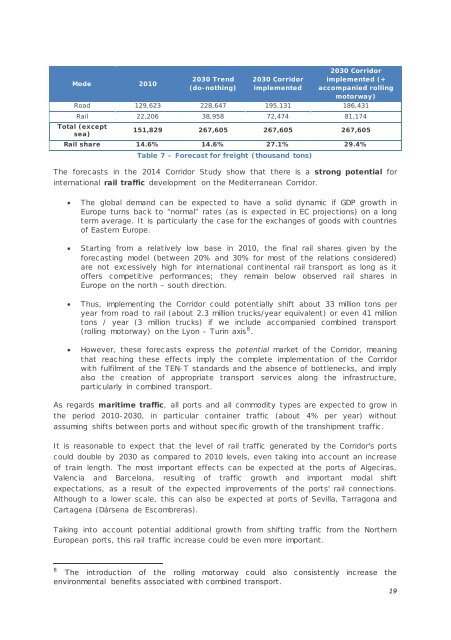Mediterranean
5Lwz6ndOG
5Lwz6ndOG
You also want an ePaper? Increase the reach of your titles
YUMPU automatically turns print PDFs into web optimized ePapers that Google loves.
Mode 2010<br />
2030 Trend<br />
(do-nothing)<br />
2030 Corridor<br />
implemented<br />
2030 Corridor<br />
implemented (+<br />
accompanied rolling<br />
motorway)<br />
Road 129,623 228,647 195,131 186,431<br />
Rail 22,206 38,958 72,474 81,174<br />
Total (except<br />
sea)<br />
151,829 267,605 267,605 267,605<br />
Rail share 14.6% 14.6% 27.1% 29.4%<br />
Table 7 – Forecast for freight (thousand tons)<br />
The forecasts in the 2014 Corridor Study show that there is a strong potential for<br />
international rail traffic development on the <strong>Mediterranean</strong> Corridor.<br />
• The global demand can be expected to have a solid dynamic if GDP growth in<br />
Europe turns back to “normal” rates (as is expected in EC projections) on a long<br />
term average. It is particularly the case for the exchanges of goods with countries<br />
of Eastern Europe.<br />
• Starting from a relatively low base in 2010, the final rail shares given by the<br />
forecasting model (between 20% and 30% for most of the relations considered)<br />
are not excessively high for international continental rail transport as long as it<br />
offers competitive performances; they remain below observed rail shares in<br />
Europe on the north – south direction.<br />
• Thus, implementing the Corridor could potentially shift about 33 million tons per<br />
year from road to rail (about 2.3 million trucks/year equivalent) or even 41 million<br />
tons / year (3 million trucks) if we include accompanied combined transport<br />
(rolling motorway) on the Lyon – Turin axis 8 .<br />
• However, these forecasts express the potential market of the Corridor, meaning<br />
that reaching these effects imply the complete implementation of the Corridor<br />
with fulfilment of the TEN-T standards and the absence of bottlenecks, and imply<br />
also the creation of appropriate transport services along the infrastructure,<br />
particularly in combined transport.<br />
As regards maritime traffic, all ports and all commodity types are expected to grow in<br />
the period 2010-2030, in particular container traffic (about 4% per year) without<br />
assuming shifts between ports and without specific growth of the transhipment traffic.<br />
It is reasonable to expect that the level of rail traffic generated by the Corridor's ports<br />
could double by 2030 as compared to 2010 levels, even taking into account an increase<br />
of train length. The most important effects can be expected at the ports of Algeciras,<br />
Valencia and Barcelona, resulting of traffic growth and important modal shift<br />
expectations, as a result of the expected improvements of the ports' rail connections.<br />
Although to a lower scale, this can also be expected at ports of Sevilla, Tarragona and<br />
Cartagena (Dársena de Escombreras).<br />
Taking into account potential additional growth from shifting traffic from the Northern<br />
European ports, this rail traffic increase could be even more important.<br />
8<br />
The introduction of the rolling motorway could also consistently increase the<br />
environmental benefits associated with combined transport.<br />
19



